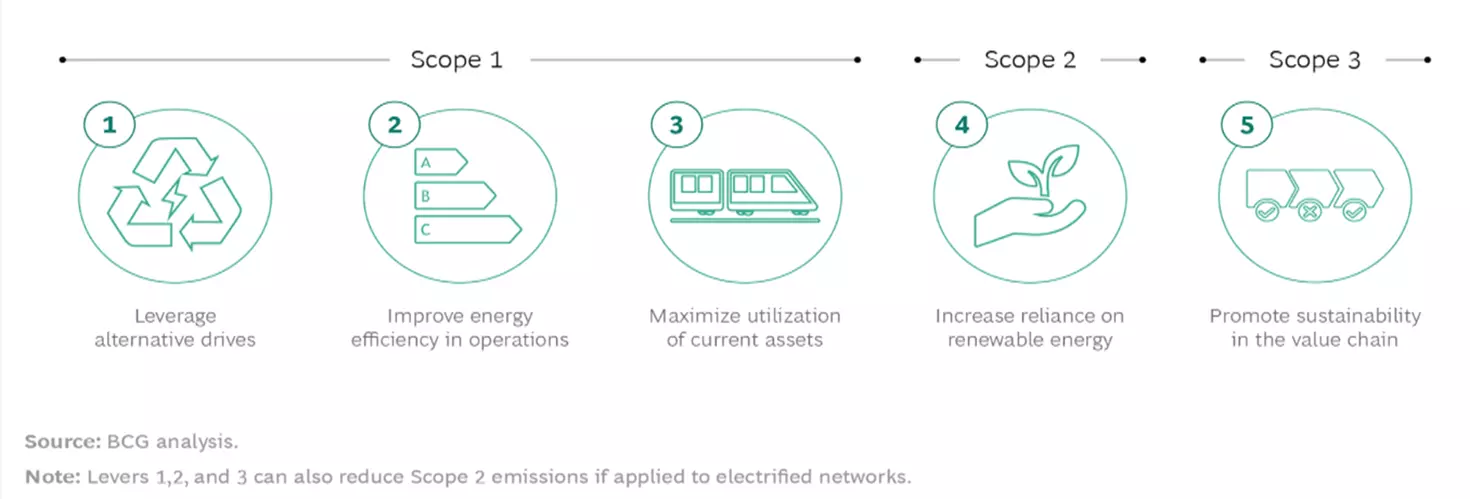The Sustainable Transport Challenge: Railway As the Answer?
Trains are among the most sustainable forms of transport, accounting for just four percent of the transport industry’s global emissions in 2019. But to achieve the emission reductions called for in the Paris Agreement, rail’s use and sustainability must be increased through the development of alternative drives, greater operational efficiency, adoption of renewable energy, and more.
As part of its Green Deal, the EU plans to invest €260 billion in rail transport. By offering a range of incentives, the EU hopes to grow the share of freight shipped via rail from 17 percent to 30 percent by 2030. If rail is to expand and grow, it must make progress in three types of emissions for which rail operators are directly or indirectly responsible:
- Scope 1 emissions are direct emissions from trains, on-site machinery, and buildings, generated primarily by fossil fuels that power locomotives, cars, and trucks.
- Scope 2 emissions are emissions created indirectly through the purchase of nonrenewable electricity that is used to power locomotives, to conduct administrative operations, to operate train stations, and to perform maintenance and other activities.
- Scope 3 emissions are other indirect GHG emissions from value chains, including upstream emissions from producing locomotives, rolling stock, and rail infrastructure and downstream emissions from third-party locomotives that run on a company’s network.
Scope 1 emissions can be reduced by deploying electrification and cleaner alternative-drive technologies for locomotives, by improving energy efficiency in operations, and by maximizing the utilization of current assets. Scope 2 emissions can be reduced by increasing the share of renewable energy purchased for rail networks, buildings, and locomotive drives — and by improving efficiency and asset utilization. Scope 3 emissions can be reduced by engaging with suppliers to decarbonize and to set green procurement criteria.
According to the International Energy Agency, 55 percent of the energy consumed by the global rail industry in 2020 was generated by diesel (85 percent of it used to power trains), 44 percent by electricity, and one percent by biofuels. Measuring, managing, and reducing Scope 1 emissions from diesel will be critical to the industry’s sustainability efforts. If global rail is to reach net zero by 2050, it must reduce its use of diesel to four percent of the energy used. Germany’s Electrification Plus program, launched in 2021, seeks to ensure that 100 percent of the country’s rail network will be electric or climate neutral.

Electrification will not significantly improve rail’s sustainability if electricity is largely generated by fossil fuels. Reducing Scope 2 emissions will require significant increase in electricity from renewable sources, primarily hydroelectric, solar, and wind. Germany’s Deutsche Bahn plans to buy an annual 190 gigawatts of electricity from the Amrumbank-West offshore wind farm over the next 15 years. France’s SNCF Energy has signed a 20-year contract with EDF Renewables to buy 25 gigawatts of renewable energy generated by a 20-megawatt solar farm opening in 2023. The UK’s Network Rail hopes to become 100 percent renewable by 2030. Japan’s JR East aims to achieve net-zero emissions by 2051 by purchasing renewable electricity and working with a subsidiary to develop its own sources of renewable energy. The Canadian Pacific Railway built a solar energy farm for its Calgary headquarters, and Indian Railways began operating the first fully solar powered rail section in 2019.
Reducing Scope 3 emissions will require a combined effort by all players in the global rail ecosystem, such as:
- Building a baseline of GHG emissions to set reduction targets for all three emission scopes and to publicly report progress. By sharing such data, operators can encourage shippers and suppliers to reduce their own emissions. Brazil’s MRS, a freight operator, has developed a calculator that shows the emissions-reducing potential of shifting from trucks to rail.
- Rail and infrastructure operators should measure, evaluate, and reduce the carbon footprints of their own products and those of their suppliers. Focusing on sustainable sourcing strategies can further extend these efforts throughout the supply chain.
- Integrating emissions data with data from suppliers will enable operators to define emissions-based procurement standards and track suppliers’ compliance. The UK’s Network Rail found two-thirds of its Scope 3 emissions came from purchased goods and services. It expects suppliers responsible for three-quarters of the operator’s Scope 3 emissions to have set their own science-based targets by 2025.
- To reduce Scope 3 emissions, the entire sector must set standards and commit to sustainable procurement practices, creating demand-side pressure to improve. In 2015, six major rail players cofounded Railsponsible to promote sustainability across the supply chain. Membership in the consortium has grown to 15 operators and suppliers, representing more than 50 billion euros in procurement spending, 44 percent of which falls under Railsponsible’s sustainable procurement agreements.
- Operational sustainability will require rethinking governance mechanisms to align with internal incentives. As part of Deutsche Bahn’s strategy to become climate neutral by 2040, the company enlisted 200 environmental coordinators to communicate the data and oversee the implementation of green projects. These coordinators work closely with other DB employees and managers to coordinate implementation, ensure adherence to environmental protection regulations, and identify environmental risks.
Those steps can be optimized and managed with SAP Profitability and Performance Management (SAP PaPM). SAP PaPM offers use case-driven sustainability solutions for SAP and non-SAP customers, from the Cloud or on-premise. It ensures traceability and auditability. It provides an efficient approach and delivers data-driven insights for optimal decision making, with an intuitive and flexible tool. It allows creation of complex business models with high granularity of data. SAP PaPM also enables business users to generate reports for internal and external use, set targets, monitor progress, and create what-if scenarios and simulations. SAP PaPM solution brings sophisticated business models for corporate value chains, as well as financial and investment sustainability (including GHG calculations) using predefined content and comprehensive allocations. It helps business users extend to deeper, richer, transparent, and harmonized results across the entire enterprise and its supply chain, while consolidating data for a single source of truth.

STEPS TO TAKE FOR MORE SUSTAINABLE LOGISTICS
Evidence of the increased attractiveness of rail can be found in different shippers’ clients, who are taking advantage of rail’s sustainability. For example, as part of its effort to reduce its carbon footprint, UK grocer Tesco is shipping a significant proportion of fresh produce from Spain by rail, a move that is expected to take 65,000 trucks off the road and reduce GHG emissions by 4,500 tons. Swedish grocer Coop has contracted with a major European logistics firm to increase its use of rail (for shipping groceries to its outlets) from 10 to 20 trains per week, which will remove an estimated 520 trucks weekly from the country’s highways.
Operators looking to grow their customer bases by becoming more sustainable should follow these concrete steps:
- Understand the potential impact of climate change on the business and reverse the environmental, social, and governmental burden the business causes. Assess the link to SDGs setting, the current situation of the company’s emissions, its statistics for electricity, renewables, and diesel consumption, as well as its KPIs (GHG, air quality, soil quality, noise pollution, land use, resource and waste management, energy/fuel efficiency, biodiversity effect, transport distances and route characteristics, load factor, commuting time ) Establish data processes to obtain and calculate those parameters. SAP PaPM has been designed to handle this aspect. Msg global with SAP PaPM addresses relevant frameworks like TCFD, SDG mapping, GRI standards, GHG Protocol, and EU Taxonomy. Other applicable schemes that can be added that provide ideas, instructions and best practices for modeling the system for specific topics and industries.
- Determine the baseline, commit to measure and review reduction initiatives: benchmarking peers will enable a company to understand and manage risks, challenges, and opportunities for its current business model. SAP PaPM can set baselines and current and target values, update baselines in case of acquisitions, and implement benchmark comparisons.
- Define sustainability ambitions, strategy, plans to deliver the desired future state. This step should include defining the sustainability context for value propositions to customers, developing new value-added products and services, analyzing the impact of initiatives, and running scenarios and simulations to identify the most cost-effective options. SAP PaPM covers this need through the range of what-if simulations.
- Begin the journey by preparing the internal capacity for the change. The roadmap should outline roles and responsibilities, expertise generation, and the organizational structure and processes needed to reach targets and to revise processes for a low-carbon culture. Process management, user groups, and roles set up in SAP PaPM serve these purposes.
- Engage the full ecosystem by partnering with suppliers and subcontractors across the value chain to explore and develop low-emissions technologies and practices. Collaborate with stakeholders by collecting, merging, and analyzing data to get joint results. SAP PaPM enables this by allowing integration with SAP and non-SAP ERP and non-ERP systems and incorporating any internal or external data in the sustainability calculations.
To reverse current negative trends, rail operators have an inherent advantage—rail is already far more climate friendly than other transport modes. The Global Rail Sustainability Taskforce was formed in 2021 with member representation from all around the world to unite the rail industry on sustainability and to champion the shift from aviation and private road vehicles to rail and green recovery of transport. By continuing to increase its sustainability efforts and its reporting, the operator is continuously updated, innovative, and safe concerning VUCA and its driving market forces. It is fully integrated to better address compliance with existing environmental standards (EN 16258, GLEC, ISO14083) and nationally determined laws. And it’s aligned with the International Union of Railways “Vision for 2030”. Furthermore, it is prepared to stay ahead of potential legislation coming into force like EU Taxonomy. Following the green agenda could directly cut through the regulatory requirements and the bureaucratic red tape that often slows new rail projects and policy changes, smooth the licensing and approval processes, and foster development by simplifying rail regulations and other measures. As a result of leading the industry in sustainability direction, it attracts customers and investors, especially the ones demanding measuring, awareness, and adjustments in ecological footprints.
References:
https://www.bcg.com/publications/2022/riding-the-rails-to-the-future-of-sustainability
https://www.sap.com/germany/products/financial-management/profitability-and-performance-management.html




